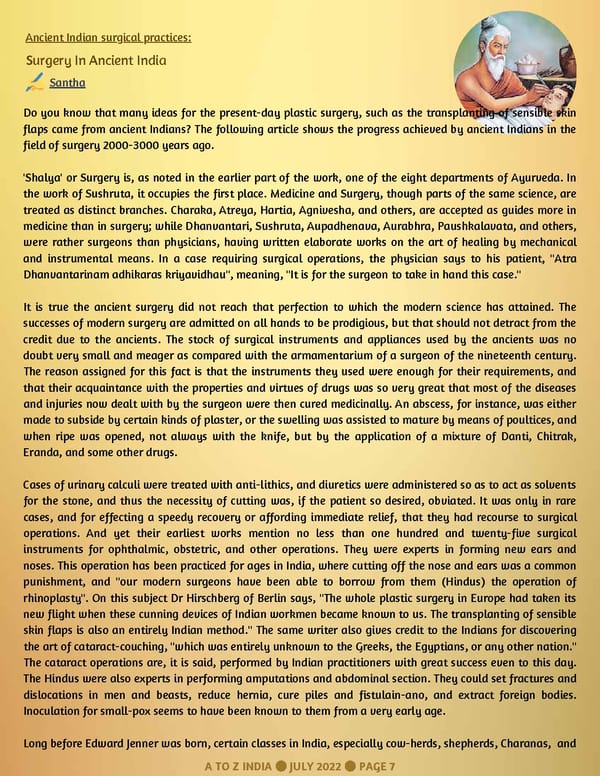Do you know that many ideas for the present-day plastic surgery, such as the transplanting of sensible skin flaps came from ancient Indians? The following article shows the progress achieved by ancient Indians in the field of surgery 2000-3000 years ago. 'Shalya' or Surgery is, as noted in the earlier part of the work, one of the eight departments of Ayurveda. In the work of Sushruta, it occupies the first place. Medicine and Surgery, though parts of the same science, are treated as distinct branches. Charaka, Atreya, Hartia, Agnivesha, and others, are accepted as guides more in medicine than in surgery; while Dhanvantari, Sushruta, Aupadhenava, Aurabhra, Paushkalavata, and others, were rather surgeons than physicians, having written elaborate works on the art of healing by mechanical and instrume ntal means. In a case requiring surgical operations, the physician says to his patient, "Atra Dhanvantarinam adhikaras kriyavidhau", meaning, "It is for the surgeon to take in hand this case." It is true the ancient surgery did not reach that perfection to which the modern science has attained. The successes of modern surgery are admitted on all hands to be prodigious, but that should not detract fro m the credit due to the ancients. The stock of surgical instruments and appliances used by the ancients was no doubt very small and meager as compared with the armamentarium of a surgeon of the nineteenth century. The reason assigned for this fact is that the instruments they used were enough for their requirements, and that their acquaintance with the properties and virtues of drugs was so very great that most of the diseases and injuries now dealt with by the surgeon were then cured medicinally. An abscess, for instance, was either made to subside by certain kinds of plaster, or the swelling was assisted to mature by means of poultices, and when ripe was opened, not always with the knife, but by the application of a mixture of Danti, Chitrak, Eranda, and some other drugs. Cases of urinary calculi were treated with anti-lithics, and diuretics were administered so as to act as solvents for the stone, and thus the necessity of cutting was, if the patient so desired, obviated. It was only in rare cases, and for effecting a speedy recovery or affording immediate relief, that they had recourse to surgical operations. And yet their earliest works mention no less than one hundred and twenty-five su rgical instruments for ophthalmic, obstetric, and other operations. They were experts in forming new ears and noses. This operation has been practiced for ages in India, where cutting off the nose and ears was a common punishment, and "our modern surgeons have been able to borrow from them (Hindus) the operation of rhinoplasty". On this subject Dr Hirschberg of Berlin says, "The whole plastic surgery i n Europe had taken its new flight when these cunning devices of Indian workmen became known to us. The transplanting of sensible skin flaps is also an entirely Indian method." The same writer also gives credit to the Indians for discovering the art of cataract-couching, "which was entirely unknown to the Greeks, the Egyptians, or any other nation." The cataract operations are, it is said, performed by I ndian practitioners with great success even to this day. The Hindus were also experts in performing amputations and abdominal section. They could set fractures and dislocations in men and beasts, reduce hernia, cure piles and fistula in-ano, and extract foreign bodies. Inoculation for small-pox seems to have been known to them from a very early age. Long before Edward Jenner was born, certain classes i n India, especially cow-herds, shepherds, Charanas, and Santha A TO Z INDIA JULY 2022 PAGE 7 Surgery In Ancient India Ancient Indian surgical practices:
 A TO Z INDIA - JULY 2022 Page 6 Page 8
A TO Z INDIA - JULY 2022 Page 6 Page 8